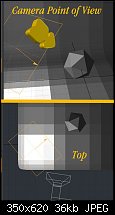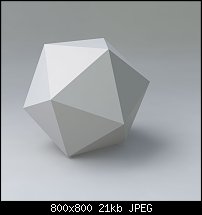Hi Javier—
I'm sorry you're having a not-fun time with this! Frances was able to do something clever and attractive by studying the images, by the way.
There is only one light, but in real life, there is more than one source of illumination, indirect lighting, also call ambient lighting—light that comes from bouncing off the surroundings, and that is why the faces closest to the floor in the image are lighter than you'd expect them to be...they are getting light from the floor.
I will try to make this example easier here, and if I fail 1.) I'm not a good teacher and 2.) give up on this one

Here is the top view of the scene, and the camera's view including the area-type light object. The arrow in the top images indicates where the light is directed, as does the orange arrow on the light itself. I also rendered the same scene with no textures.


Are these good hints to work from?






 Reply With Quote
Reply With Quote



 .
.



Bookmarks